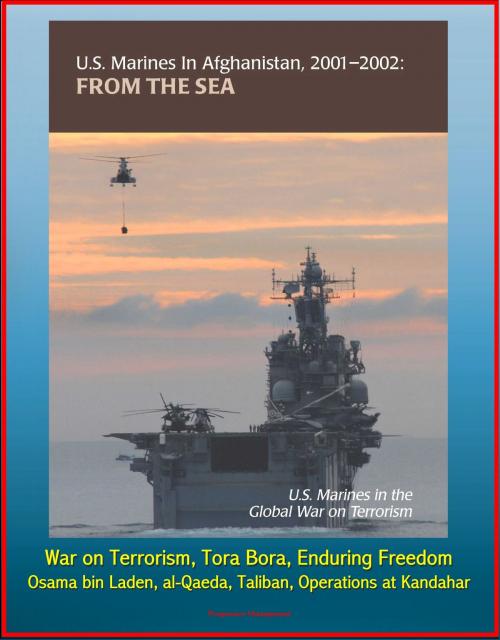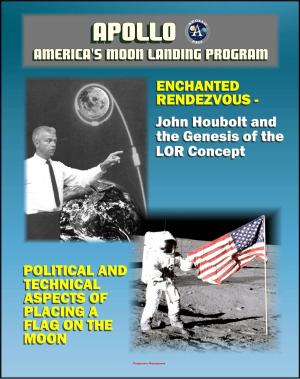U.S. Marines in Afghanistan, 2001-2002: From the Sea - U.S. Marines in the Global War on Terrorism, Tora Bora, Enduring Freedom, Osama bin Laden, al-Qaeda, Taliban, Operations at Kandahar
Nonfiction, History, Military| Author: | Progressive Management | ISBN: | 9781301006847 |
| Publisher: | Progressive Management | Publication: | December 10, 2012 |
| Imprint: | Smashwords Edition | Language: | English |
| Author: | Progressive Management |
| ISBN: | 9781301006847 |
| Publisher: | Progressive Management |
| Publication: | December 10, 2012 |
| Imprint: | Smashwords Edition |
| Language: | English |
This project began almost 10 years ago, a month after the terrorist attacks on 11 September 2001. Drawn from a variety of sources, the account reflects the combined efforts of three related, yet independent, endeavors to document Marine operations in Afghanistan during the opening days of Operation Enduring Freedom. In November 2001, after it became apparent that a sizable Marine force was about to be committed to the ongoing campaign, History and Museums Division began to assemble a small field documentation team to accompany the operating forces as official observers. The team—consisting of two field historians, a combat photographer, and a combat artist—intended to collect documents, capture images, conduct interviews, and gather artifacts that would help to preserve, present, and promote Marine Corps history.
In early December, shortly after Naval Expeditionary Task Force 58 seized Objective Rhino in southern Afghanistan, Headquarters Marine Corps directed that the field history detachment join a provisional Combat Assessment Team then forming in Quantico, Virginia. Modeled on the Battle Assessment Team deployed during the Gulf War, the platoon-sized organization was a Marine Corps Combat Development Center initiative to evaluate and improve the Marine Corps' warfighting capabilities. After several iterations, this effort evolved into today's Marine Corps Center for Lessons Learned.
This monograph is more than the story of Marine expeditionary operations in Afghanistan. It describes who our nation's enemies are; how America became involved in the Global War on Terrorism; and how the Marine Corps struggled to acquire a major role in Operation Enduring Freedom, as well as the actions of Marines and sailors who helped prosecute the air and ground campaigns against Taliban and al-Qaeda forces. In the latter regard, we see the 15th Marine Expeditionary Unit, already forward deployed on 11 September 2001, ready to conduct a noncombatant evacuation operation, secure a forward operating base, or provide a quick reaction force for joint special operating forces conducting the initial offensive action of the war. The 15th Marine Expeditionary Unit then combined with the 26th Marine Expeditionary Unit and quickly maneuvered from the Mediterranean to form a provisional Marine expeditionary brigade known as Naval Expeditionary Task Force 58. Working simultaneously under the direction of U.S. Central Command's land and maritime component commanders and in association with joint special operations forces, Brigadier General James N. Mattis and his force embarked on a sequence of operations in southern Afghanistan. These included, but were not limited to, establishing Forward Operating Base Rhino, interdicting enemy lines of communications along Highway 1, occupying Kandahar International Airport, securing the American embassy in Kabul, detaining several hundred prisoners of war, and supporting special operations forces during numerous sensitive site exploitation and special reconnaissance missions. The monograph also describes the 13th Marine Expeditionary Unit's rapid reinforcement of Coalition forces during Operation Anaconda, only days after Task Force 58's disbandment.
Prologue * Soviet-Afghan War and Beyond * Chapter 1 * The Global War on Terrorism * Chapter 2 * Operation Enduring Freedom * Chapter 3 * Striking Back * Chapter 4 * Changing Plans * Chapter 5 * Naval Expeditionary Task Force 58 * Chapter 6 * Operational Maneuver from the Sea * Chapter 7 * Operation Swift Freedom * Chapter 8 * Concurrent and Distributed Operations at Forward Operating Base Rhino * Chapter 9 * Interdiction Operations * Chapter 10 * Occupation and Exploitation Operations * Chapter 11 * Concurrent and Distributed Operations at Kandahar * Chapter 12 * Tora Bora * Chapter 13 * Sensitive Site Exploitation and Security Missions * Chapter 14 * Winding Down * Chapter 15 * Marines during Operation Anaconda
This project began almost 10 years ago, a month after the terrorist attacks on 11 September 2001. Drawn from a variety of sources, the account reflects the combined efforts of three related, yet independent, endeavors to document Marine operations in Afghanistan during the opening days of Operation Enduring Freedom. In November 2001, after it became apparent that a sizable Marine force was about to be committed to the ongoing campaign, History and Museums Division began to assemble a small field documentation team to accompany the operating forces as official observers. The team—consisting of two field historians, a combat photographer, and a combat artist—intended to collect documents, capture images, conduct interviews, and gather artifacts that would help to preserve, present, and promote Marine Corps history.
In early December, shortly after Naval Expeditionary Task Force 58 seized Objective Rhino in southern Afghanistan, Headquarters Marine Corps directed that the field history detachment join a provisional Combat Assessment Team then forming in Quantico, Virginia. Modeled on the Battle Assessment Team deployed during the Gulf War, the platoon-sized organization was a Marine Corps Combat Development Center initiative to evaluate and improve the Marine Corps' warfighting capabilities. After several iterations, this effort evolved into today's Marine Corps Center for Lessons Learned.
This monograph is more than the story of Marine expeditionary operations in Afghanistan. It describes who our nation's enemies are; how America became involved in the Global War on Terrorism; and how the Marine Corps struggled to acquire a major role in Operation Enduring Freedom, as well as the actions of Marines and sailors who helped prosecute the air and ground campaigns against Taliban and al-Qaeda forces. In the latter regard, we see the 15th Marine Expeditionary Unit, already forward deployed on 11 September 2001, ready to conduct a noncombatant evacuation operation, secure a forward operating base, or provide a quick reaction force for joint special operating forces conducting the initial offensive action of the war. The 15th Marine Expeditionary Unit then combined with the 26th Marine Expeditionary Unit and quickly maneuvered from the Mediterranean to form a provisional Marine expeditionary brigade known as Naval Expeditionary Task Force 58. Working simultaneously under the direction of U.S. Central Command's land and maritime component commanders and in association with joint special operations forces, Brigadier General James N. Mattis and his force embarked on a sequence of operations in southern Afghanistan. These included, but were not limited to, establishing Forward Operating Base Rhino, interdicting enemy lines of communications along Highway 1, occupying Kandahar International Airport, securing the American embassy in Kabul, detaining several hundred prisoners of war, and supporting special operations forces during numerous sensitive site exploitation and special reconnaissance missions. The monograph also describes the 13th Marine Expeditionary Unit's rapid reinforcement of Coalition forces during Operation Anaconda, only days after Task Force 58's disbandment.
Prologue * Soviet-Afghan War and Beyond * Chapter 1 * The Global War on Terrorism * Chapter 2 * Operation Enduring Freedom * Chapter 3 * Striking Back * Chapter 4 * Changing Plans * Chapter 5 * Naval Expeditionary Task Force 58 * Chapter 6 * Operational Maneuver from the Sea * Chapter 7 * Operation Swift Freedom * Chapter 8 * Concurrent and Distributed Operations at Forward Operating Base Rhino * Chapter 9 * Interdiction Operations * Chapter 10 * Occupation and Exploitation Operations * Chapter 11 * Concurrent and Distributed Operations at Kandahar * Chapter 12 * Tora Bora * Chapter 13 * Sensitive Site Exploitation and Security Missions * Chapter 14 * Winding Down * Chapter 15 * Marines during Operation Anaconda















